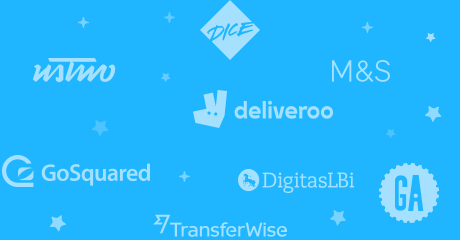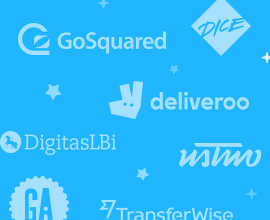It’s not “sexy” but who says it can’t be? Complexity and ambiguity can offer valuable moments for inspiring beautiful novelty in enterprise UX.
It’s 2015. As I gaze back upon my circuitous career path, for over a dozen years, I’ve largely designed for desktop virtualization, corporate financials, and now cloud analytics for IT admins. B2B. Verticals. Enterprise. Whoa. It wasn’t supposed to be this way—really!
I had it all figured out in the waning weeks of finishing my interaction design degree. Amid the typical job hunt via career fairs and phone screens, I brashly foresaw myself at IDEO, or Sony, or frogdesign, or maybe even Apple. And I would create something cool. Something sexy. Digital jewelry or maybe holographic touch-screens! Instead, the economy was crashing all around us that Spring of 2001 with the dot-com collapse of hubris and profits (vaporous, as it were). And so I humbly took a job with Oracle to design web-based financial software in sunny Silicon Valley… Much has changed since then, including my outlook and understanding of what I got myself into.
"There is a sobering level of scale and impact."
Why do I design enterprise software?
What would compel a designer to apply his or her broad intellect & wild creativity to this particular realm of user experience?
I’d like to offer a personal perspective, based upon my practice at a range of firms like Oracle, Adobe, and Citrix, in the hopes of 1) demystifying a generally unknown problem space and 2) inspiring today’s designers to take up this challenge, improving the current state while defining what’s next.
First, let’s decipher what is meant by “Enterprise software”. I know… At first mention of that phrase, certain endearing qualities come to mind: It’s boring, messy, inscrutable, rife with absurd levels of hair-splitting complexity and teeth-grinding confusion, sold to penny-conscious buyers who don’t use the product, while “end users” are conscripted to use it, with dull training. Regulations for security, accessibility, localization are brutally tedious and restrictive. And… it all looks like it was made in 1989, with the worst. color palettes. ever. Sounds like a real bucket of fun for a designer, doesn’t it?
Now, all of that may be true, but here’s what I have realized — Enterprise software enables the primary functions that run a company (or a government, or a university, or a hospital, or an industrial plant, or a transit terminal, or any sufficiently complex organization) to ensure things are running smoothly — the delivery of vital information, critical communications, and essential processes that help workers get stuff done. Vital person-data-task dependencies are at stake, to make decisions that impact literally millions or billions of dollars in waste — or in savings. There is a sobering level of scale and impact. These are necessary tools that engineers, HR staff, plant managers, IT admins, financial analysts, insurance brokers—even top-level executives—must use on a daily basis to do their jobs, from 9 to 5 (and often beyond), to somehow be accomplished. Consequences and accountability are on the line at a surprisingly personal level.
"Consequences and accountability are on the line at a surprisingly personal level."
You see, with Enterprise UX it’s all about framing the problem & seeing the opportunity. And seeing where to tap multitudes of potential to transform a dreary software encounter into something rewarding, like a delightful consumer app or futuristic concept car.
But I’m getting ahead of myself; let’s continue itemizing common attributes of Enterprise software.
- Domain-Specific: Enterprise software is created to serve the needs of a specialized audience. This audience thrives on a particular foundation of concepts and terminology unique to their domain, whether it’s ER nurses or IT admins or CB dispatchers. They each have certain habits, tools, and values to be understood and supported. Indeed, it’s quite more than a domain, it’s a tribe, rich in cultural “heritage”, so to speak.
- Data Model: All software (even social apps or fun games) have a data model underlying its interface and interaction. There are discrete objects with attributes or parameters, with certain actions that can or cannot be taken, bound by a logical relationship. In Enterprise software, due to the domain specialization, this data model can be mind-blowingly complex, an ontology spanning several levels or tiers intrinsic to its existence and utility. Grokking it is a big challenge, yet helps in preventing it from being dumped all over the interface!
- Customized: In my experience, Enterprise solutions typically require heavy amounts of customizability, because of detailed needs of a certain buyer (this relates to the Sales process, described later), who is likely in the unenviable position of purchasing several different services that must somehow cooperate securely and seamlessly (insert stifled laughter here). These dynamic heterogenous systems are highly complex, very costly, and demand scrutiny to deliver value. Hence, the need to create something highly customizable and modular to serve that demand.
- Ecosystem: Because of the need to work within mixed, elaborate setups of multiple solutions from multiple vendors and brands and protocols, there’s a daunting “ecosystem” aspect that must be considered in designing Enterprise UX. This surpasses the now canonical “iPod ecosystem” model (syncing your iPod to the iTunes store), but speaks to expansive, mostly invisible ripple effects of user interaction flows, data clarity & mutability, notifications and messaging, roles/permissions of use, findability of objects, in an “ecosystem” of dashboards, portals, modules… some of which may not have visibility into each other! Oy.
- Sales Channel: Ah, here’s perhaps the biggest differentiator of all from consumer products. The buyer is not the user. These are not products you breezily pick up at Best Buy or the Apple Store on your way back from lunch, sadly. There is a heavily managed sales process, with formal channels of awareness, marketing, engagement, and demo’ing via “proof of concept” (which can take weeks or months to setup). The process is necessarily “high touch” with sales engineers clarifying technical details, and sales reps closing the deal, involving licenses or subscriptions—and a stack of support services, on top of that! This is typically true for cloud-based Enterprise services, although some recent startups are trying to shift this model a bit.
And to put a bow on this, there is simply unprecedented scale: literally thousands, or hundreds of thousands of objects with hundreds of actions to be performed (involving more than a few error and edge cases!) by user populations spanning multiple geographies. (Yes, I realize Twitter and Facebook have 100's+ millions of users but that’s not the same—unless you’re talking about designing the back-end apps for analyzing millions of users’ data points.)
So: Designing Enterprise UX consists of balancing inherent complexity and specialization, arbitrating across a range of demands from not only users but also buyers, pressured by broader ecosystem demands.
Why in the world would someone want to design for this? Well, it’s the challenge, of course! For me, it comes down to three things:
** Wrangling with complexity & ambiguity. There’s a level of intellectual engagement that keeps me focused, stimulated, and always learning. Sure, the details can be dull and my brain feels full. But I’m connecting dots and making discoveries. The complexity of a financial service or a “Big Data” app can be intricate puzzles to be deconstructed, and reconstructed again in a far better, simplified, easier model. How can you make it even cleaner and more elegant? Of course, it can be frustrating and overwhelming at times, but therein lies the opportunity to apply design skills efficiently and effectively for superior outcomes.
** Influencing systems-level problems. An icon or a widget is an essential touchpoint for a micro-interaction to occur. They are also gateways to deeper connections across other parts of a product or service spanning an entire business (expressed as user journeys & workflows). This necessitates a nuanced understanding of how such elements relate in terms of the purpose, flow, and utility of the software system overall, which requires more investigative conversations with stakeholders and customers alike. Remember— these users inhabit, actually “live”, inside these systems all day to get their jobs done! And they usually see only one small part of it (maybe just 3–5 screens), but your job as a designer is to devise a clean, elegant UX model for the whole system.
** But mostly, I’m just driven by the persistent nagging thorn of making Enterprise beautiful as hell. It doesn’t have to be ugly! Texture, motion, balance, tone, style—we can ascribe those qualities to Enterprise UX. We are surrounded by poignant products or services like the Nest, iPhone, Tesla or customer services at a chocolatier like Cocoa Bella or hotelier like Ritz-Carlton. Why shouldn’t we imbue such delightful, charismatic qualities into the software that run our businesses, that are used by working folks 9 hours a day, every day? After all, we are all human beings at the end of the day craving moments of joy and satisfaction. We can make Enterprise UX sexy, bold, amazing, elegant, and yes… cool. It’s starting to happen already with various startups tackling Enterprise problems, from New Relic to Workday to ZenDesk. And thankfully, cool consumer products like the iPhone have raised popular expectations to demand higher quality UX—even at the office. It’s a matter of determination and persistence of passion to deliver what we all fundamentally desire—a beautiful experience. And Sales will love it ;-)
"I’m just driven by the persistent nagging thorn of making Enterprise beautiful as hell."
If you’re now inspired by this, you may be wondering who can and should take up the challenge of designing Enterprise UX successfully?
It’s admittedly not for everyone. There’s a certain mature, strategic outlook requiring a patient, yet passionate demeanor to excel in this space. It’s not initially sexy or cool but it is intellectually demanding, with significant impact at huge scales of people and money. You have to provoke those opportunities for novel creative expression in Enterprise, using compelling graphics and prototypes to convey your point of view. And it can be deeply frustrating and often quite overwhelming, yet I’d encourage those designers with the passion, stamina, curiosity, and a mature approach to address theses challenge themselves—perhaps strike a new path for Enterprise UX!
After all, you would be designing for people who will use what you create, at least 40–60 hours a week so they can go home feeling satisfied, accomplished, and quite possibly, even a little bit heroic. The potential is there, and designers with the tenacity and will can make it happen.
So, who’s with me? Let’s design beautiful Enterprise UX.
This post was originally published on Uday's Medium profile.


